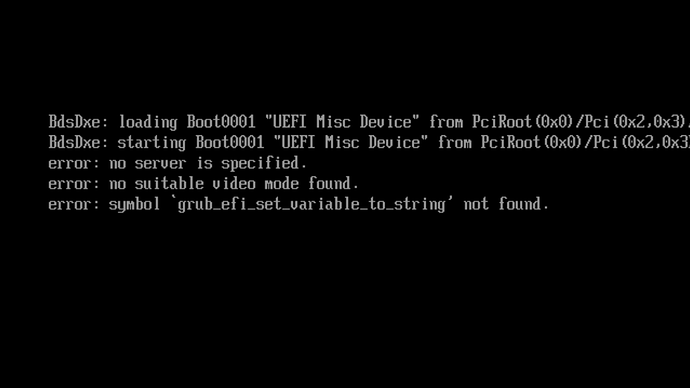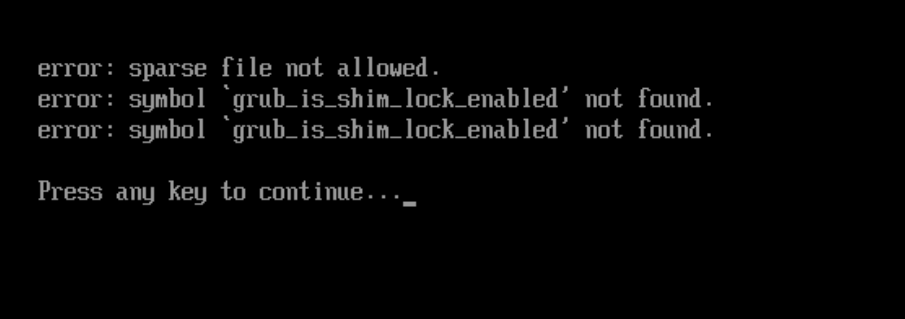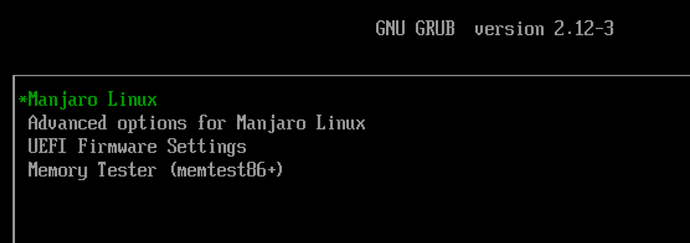I hope i’m in the right place!
Since the last update of manjaro , my virtual machines (KVM/libvirt) won’t start! I was getting the following error:
Unable to find ‘efi’ firmware that is compatible with the current configuration
And I found the following:
https://bbs.archlinux.org/viewtopic.php?id=300862
virsh -c qemu:///system edit $VMname
/usr/share/edk2/x64/OVMF_CODE.fd -> /usr/share/edk2/x64/OVMF_CODE.4m.fd
/usr/share/edk2/x64/OVMF_VARS.fd -> /usr/share/edk2/x64/OVMF_VARS.4m.fd
When I changed it, the VM finally starts but… It won’t boot any further then this:
After that I see the grub menu and it won’t boot to the manjaro OS (KDE):
My virtual machine is pretty old, but always kept up-to-date. I updated the host first, but now I’m not able to boot into my VM. How can I fix this? I’m no linux wizard, most of the time it just works for me
Hanzel
2 December 2024 19:54
2
Hi,
This issue looks (and refers to the same arch forum post) to something seen before:
Would this be a KVM/QEMU instance?
There was one solution for Fedora:
qemu-img convert -f raw -O qcow2 WINDOWS10-EFI_VARS.fd WINDOWS10-EFI_VARS.qcow2
Thanks for the help, I have updated my post with an extra image.
The solution proposed in the topic didn’t help me. I tried the following.
cp /usr/share/edk2/x64/OVMF_VARS.4m.fd /var/lib/libvirt/qemu/nvram/testing_VARS.fd
That didn’t work, so I looked at the qemu-img convert ... command.
I didn’t know what to change for the qemu-img convert command from that post, in my xml. As you can see, I don’t have anything with qcow2 in the following folder (in the topic they have that for secboot.).
This is the content of /usr/share/edk2/x64:
-rw-r--r-- 1 root root 4194304 nov 10 21:16 MICROVM.4m.fd
-rw-r--r-- 1 root root 4194304 nov 10 21:16 OVMF.4m.fd
-rw-r--r-- 1 root root 3653632 nov 10 21:16 OVMF_CODE.4m.fd
-rw-r--r-- 1 root root 3653632 nov 10 21:16 OVMF_CODE.secboot.4m.fd
-rw-r--r-- 1 root root 540672 nov 10 21:16 OVMF_VARS.4m.fd
My XML (my virtual disk (qcow2 file) is on another disk on my systems) :
xml
<domain type="kvm">
<name>testing</name>
<uuid>9b2061a7-38f5-4745-a416-686dbdc37f77</uuid>
<metadata>
<libosinfo:libosinfo xmlns:libosinfo="http://libosinfo.org/xmlns/libvirt/domain/1.0">
<libosinfo:os id="http://manjaro.org/manjaro/rolling"/>
</libosinfo:libosinfo>
</metadata>
<memory unit="KiB">25165824</memory>
<currentMemory unit="KiB">25165824</currentMemory>
<memoryBacking>
<source type="memfd"/>
<access mode="shared"/>
</memoryBacking>
<vcpu placement="static">16</vcpu>
<os firmware="efi">
<type arch="x86_64" machine="pc-q35-7.2">hvm</type>
<firmware>
<feature enabled="no" name="enrolled-keys"/>
<feature enabled="no" name="secure-boot"/>
</firmware>
<loader readonly="yes" type="pflash">/usr/share/edk2/x64/OVMF_CODE.4m.fd</loader>
<nvram template="/usr/share/edk2/x64/OVMF_VARS.4m.fd">/var/lib/libvirt/qemu/nvram/testing_VARS.fd</nvram>
<bootmenu enable="yes"/>
</os>
<features>
<acpi/>
<apic/>
<vmport state="off"/>
</features>
<cpu mode="host-passthrough" check="none" migratable="on">
<topology sockets="1" dies="1" clusters="1" cores="8" threads="2"/>
<feature policy="require" name="topoext"/>
</cpu>
<clock offset="utc">
<timer name="rtc" tickpolicy="catchup"/>
<timer name="pit" tickpolicy="delay"/>
<timer name="hpet" present="no"/>
</clock>
<on_poweroff>destroy</on_poweroff>
<on_reboot>restart</on_reboot>
<on_crash>destroy</on_crash>
<pm>
<suspend-to-mem enabled="no"/>
<suspend-to-disk enabled="no"/>
</pm>
<devices>
<emulator>/usr/bin/qemu-system-x86_64</emulator>
<disk type="file" device="disk">
<driver name="qemu" type="qcow2" discard="unmap"/>
<source file="/home/brutal/nvme2/libvirt/images/testing.qcow2"/>
<target dev="vda" bus="virtio"/>
<boot order="1"/>
<address type="pci" domain="0x0000" bus="0x04" slot="0x00" function="0x0"/>
</disk>
<disk type="file" device="cdrom">
<driver name="qemu" type="raw"/>
<target dev="sda" bus="sata"/>
<readonly/>
<boot order="2"/>
<address type="drive" controller="0" bus="0" target="0" unit="0"/>
</disk>
<controller type="usb" index="0" model="qemu-xhci" ports="15">
<address type="pci" domain="0x0000" bus="0x02" slot="0x00" function="0x0"/>
</controller>
<controller type="pci" index="0" model="pcie-root"/>
<controller type="pci" index="1" model="pcie-root-port">
<model name="pcie-root-port"/>
<target chassis="1" port="0x10"/>
<address type="pci" domain="0x0000" bus="0x00" slot="0x02" function="0x0" multifunction="on"/>
</controller>
<controller type="pci" index="2" model="pcie-root-port">
<model name="pcie-root-port"/>
<target chassis="2" port="0x11"/>
<address type="pci" domain="0x0000" bus="0x00" slot="0x02" function="0x1"/>
</controller>
<controller type="pci" index="3" model="pcie-root-port">
<model name="pcie-root-port"/>
<target chassis="3" port="0x12"/>
<address type="pci" domain="0x0000" bus="0x00" slot="0x02" function="0x2"/>
</controller>
<controller type="pci" index="4" model="pcie-root-port">
<model name="pcie-root-port"/>
<target chassis="4" port="0x13"/>
<address type="pci" domain="0x0000" bus="0x00" slot="0x02" function="0x3"/>
</controller>
<controller type="pci" index="5" model="pcie-root-port">
<model name="pcie-root-port"/>
<target chassis="5" port="0x14"/>
<address type="pci" domain="0x0000" bus="0x00" slot="0x02" function="0x4"/>
</controller>
<controller type="pci" index="6" model="pcie-root-port">
<model name="pcie-root-port"/>
<target chassis="6" port="0x15"/>
<address type="pci" domain="0x0000" bus="0x00" slot="0x02" function="0x5"/>
</controller>
<controller type="pci" index="7" model="pcie-root-port">
<model name="pcie-root-port"/>
<target chassis="7" port="0x16"/>
<address type="pci" domain="0x0000" bus="0x00" slot="0x02" function="0x6"/>
</controller>
<controller type="pci" index="8" model="pcie-root-port">
<model name="pcie-root-port"/>
<target chassis="8" port="0x17"/>
<address type="pci" domain="0x0000" bus="0x00" slot="0x02" function="0x7"/>
</controller>
<controller type="pci" index="9" model="pcie-root-port">
<model name="pcie-root-port"/>
<target chassis="9" port="0x18"/>
<address type="pci" domain="0x0000" bus="0x00" slot="0x03" function="0x0" multifunction="on"/>
</controller>
<controller type="pci" index="10" model="pcie-root-port">
<model name="pcie-root-port"/>
<target chassis="10" port="0x19"/>
<address type="pci" domain="0x0000" bus="0x00" slot="0x03" function="0x1"/>
</controller>
<controller type="pci" index="11" model="pcie-root-port">
<model name="pcie-root-port"/>
<target chassis="11" port="0x1a"/>
<address type="pci" domain="0x0000" bus="0x00" slot="0x03" function="0x2"/>
</controller>
<controller type="pci" index="12" model="pcie-root-port">
<model name="pcie-root-port"/>
<target chassis="12" port="0x1b"/>
<address type="pci" domain="0x0000" bus="0x00" slot="0x03" function="0x3"/>
</controller>
<controller type="pci" index="13" model="pcie-root-port">
<model name="pcie-root-port"/>
<target chassis="13" port="0x1c"/>
<address type="pci" domain="0x0000" bus="0x00" slot="0x03" function="0x4"/>
</controller>
<controller type="pci" index="14" model="pcie-root-port">
<model name="pcie-root-port"/>
<target chassis="14" port="0x1d"/>
<address type="pci" domain="0x0000" bus="0x00" slot="0x03" function="0x5"/>
</controller>
<controller type="pci" index="15" model="pcie-root-port">
<model name="pcie-root-port"/>
<target chassis="15" port="0x1e"/>
<address type="pci" domain="0x0000" bus="0x00" slot="0x03" function="0x6"/>
</controller>
<controller type="pci" index="16" model="pcie-to-pci-bridge">
<model name="pcie-pci-bridge"/>
<address type="pci" domain="0x0000" bus="0x08" slot="0x00" function="0x0"/>
</controller>
<controller type="sata" index="0">
<address type="pci" domain="0x0000" bus="0x00" slot="0x1f" function="0x2"/>
</controller>
<controller type="virtio-serial" index="0">
<address type="pci" domain="0x0000" bus="0x03" slot="0x00" function="0x0"/>
</controller>
<filesystem type="mount" accessmode="passthrough">
<driver type="virtiofs"/>
<source dir="/home/brutal/Documents/VM/testing"/>
<target dir="/mnt_testing"/>
<address type="pci" domain="0x0000" bus="0x07" slot="0x00" function="0x0"/>
</filesystem>
<interface type="network">
<mac address="52:54:00:99:25:eb"/>
<source network="default"/>
<model type="virtio"/>
<address type="pci" domain="0x0000" bus="0x01" slot="0x00" function="0x0"/>
</interface>
<serial type="pty">
<target type="isa-serial" port="0">
<model name="isa-serial"/>
</target>
</serial>
<console type="pty">
<target type="serial" port="0"/>
</console>
<channel type="spicevmc">
<target type="virtio" name="com.redhat.spice.0"/>
<address type="virtio-serial" controller="0" bus="0" port="2"/>
</channel>
<input type="tablet" bus="usb">
<address type="usb" bus="0" port="1"/>
</input>
<input type="mouse" bus="ps2"/>
<input type="keyboard" bus="ps2"/>
<graphics type="spice">
<listen type="none"/>
<image compression="off"/>
<gl enable="yes" rendernode="/dev/dri/by-path/pci-0000:0d:00.0-render"/>
</graphics>
<sound model="ich9">
<address type="pci" domain="0x0000" bus="0x00" slot="0x1b" function="0x0"/>
</sound>
<audio id="1" type="spice"/>
<video>
<model type="virtio" heads="1" primary="yes">
<acceleration accel3d="yes"/>
<resolution x="2560" y="1363"/>
</model>
<address type="pci" domain="0x0000" bus="0x00" slot="0x01" function="0x0"/>
</video>
<redirdev bus="usb" type="spicevmc">
<address type="usb" bus="0" port="2"/>
</redirdev>
<redirdev bus="usb" type="spicevmc">
<address type="usb" bus="0" port="3"/>
</redirdev>
<watchdog model="itco" action="reset"/>
<memballoon model="virtio">
<address type="pci" domain="0x0000" bus="0x05" slot="0x00" function="0x0"/>
</memballoon>
<rng model="virtio">
<backend model="random">/dev/urandom</backend>
<address type="pci" domain="0x0000" bus="0x06" slot="0x00" function="0x0"/>
</rng>
</devices>
</domain>
Has someone a fix for, I really need this VM.
I’m in a similar pickle - I literally buried my Windows partition 6 weeks ago and now my VM has gone and I need Windows for something - Not impressed right now.
I’ve managed to get it to boot without error by changing my XML OS section as follows…
<os firmware="efi">
<type arch="x86_64" machine="pc-q35-8.0">hvm</type>
<firmware>
<feature enabled="no" name="enrolled-keys"/>
<feature enabled="yes" name="secure-boot"/>
</firmware>
<loader readonly="yes" secure="yes" type="pflash" format="raw">/usr/share/edk2/x64/OVMF_CODE.secboot.4m.fd</loader>
<nvram template="/usr/share/edk2/x64/OVMF_VARS.4m.fd" templateFormat="raw" format="raw">/var/lib/libvirt/qemu/nvram/Win11_VARS.fd</nvram>
<boot dev="hd"/>
</os>
from the following…
<loader readonly="yes" secure="yes" type="pflash" format="raw">/usr/share/edk2/x64/OVMF_CODE.secboot.fd</loader>
<nvram template="/usr/share/edk2/x64/OVMF_VARS.fd" templateFormat="raw" format="raw">/var/lib/libvirt/qemu/nvram/Win11_VARS.fd</nvram>
Essentially adding 4m where appropriate but now I get a VM that starts up but I just get a black screen saying “Display output is not active”
![]() .
.

